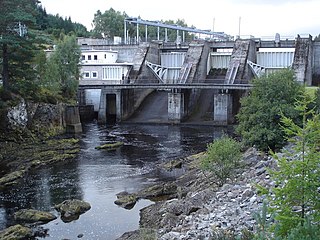Related Research Articles
The Central Electricity Generating Board (CEGB) was responsible for electricity generation, transmission and bulk sales in England and Wales from 1958 until privatisation of the electricity industry in the 1990s.
The Central Electricity Authority (CEA) was a body that managed and operated the electricity supply industry in England and Wales between 1 April 1955 and 31 December 1957. The CEA replaced the earlier British Electricity Authority (BEA) as a result of the Electricity Reorganisation (Scotland) Act 1954, which moved responsibility for Scottish electricity supply to the Scottish Office.
The United Kingdom Central Electricity Board (CEB) was established by the Electricity (Supply) Act 1926. It had the duty to supply electricity to authorised electricity undertakers, to determine which power stations would be 'selected' stations to generate electricity for the board, to provide main transmission lines to interconnect selected stations and electricity undertakers, and to standardise generating frequency.
The Electricity Commissioners were a department of the United Kingdom government's Ministry of Transport, which regulated the electricity supply industry from 1920 until nationalisation in 1948. It was responsible for securing reorganisation on a regional basis and considered schemes for centralisation in a small number of large generating stations owned by joint electricity authorities.

The Electricity Act 1947 was an Act of the Parliament of the United Kingdom which nationalised, or bought into state control, the electricity supply industry in Great Britain. It established a central authority called the British Electricity Authority (BEA) to own and operate all public electricity generation and transmission facilities and created 14 area electricity boards with a duty to acquire bulk supplies of electricity from the central authority and to distribute and sell electricity economically and efficiently to industrial, commercial and domestic consumers. It vested 505 separate local authority and company owned electricity undertakings in the BEA with effect from 1 April 1948. The Electricity Act 1947 is one of a number of Acts promulgated by the post-war Labour government to nationalise elements of the UK’s industrial infrastructure; other Acts include the Coal Industry Nationalisation Act 1946; Transport Act 1947 ; Gas Act 1948; and Iron and Steel Act 1949.
The Electricity Council was a governmental body set up in 1958 to oversee the electricity supply industry in England and Wales.

The North of Scotland Hydro-Electric Board (1943–1990) was founded to design, construct and manage hydroelectricity projects in the Highlands of Scotland. It is regarded as one of the major achievements of Scottish politician Thomas Johnston, who chaired the board from 1945 to 1959.
SWALEC was an electricity supply and distribution company in South Wales, established in 1989 following the de-regulation of the electricity supply industry in the United Kingdom. The business has seen several changes of ownership from 1996, and the SWALEC brand has been used for retail gas supply as well as electricity. Today Western Power Distribution runs the distribution network business, and SWALEC Contracting is a trading name of OVO Energy.
The South of Scotland Electricity Board (SSEB) generated, transmitted and distributed electricity throughout the south of Scotland, including the former regions of Strathclyde, Lothian, Fife, Central, Borders and Dumfries and Galloway and a few towns in northern England. It operated from 1955 to 1991.
The East Midlands Electricity Board (EMEB) was formed in 1947 as one of the United Kingdom's twelve area electricity boards specified under the Electricity Act 1947. In 1990 it was floated on the stock market as East Midlands Electricity plc, which went through several changes of ownership.
Southern Electric plc was a public limited energy company in the United Kingdom between 1990 and 1998, when it merged with Scottish Hydro-Electric plc to form Scottish and Southern Energy plc. The company had its origins in the southern England region of the British nationalised electricity industry. Created in 1948 as the Southern Electricity Board, in 1990 it was privatised by being floated on the London Stock Exchange.

Yorkshire Electricity was an electricity distribution utility in England, serving much of Yorkshire and parts of Derbyshire, Lincolnshire and Nottinghamshire.
Seeboard, formerly South Eastern Electricity Board (SEEB), was a British electricity company. The electrical power industry in the United Kingdom was nationalised by the Electricity Act 1947, when over 600 electric power companies were merged into 12 area boards, one of which was the South Eastern Electricity Board. It acquired the former Princes Hotel on the seafront in Hove, East Sussex, and converted it into its headquarters. The building was refurbished and substantially extended between 1979 and 1981.

British Gas is an energy and home services provider in the United Kingdom. It is the trading name of British Gas Services Limited and British Gas New Heating Limited, both subsidiaries of Centrica. Serving around twelve million homes in the United Kingdom, British Gas is the biggest energy supplier in the country, and is considered one of the Big Six dominating the gas and electricity market in the United Kingdom.

The Electricity Act 1957 was an Act of Parliament of the United Kingdom. The principal impact of the Act was the dissolution of the Central Electricity Authority, which it replaced with the Central Electricity Generating Board (CEGB) and the Electricity Council.
The area gas boards were created under the provisions of the Gas Act 1948 enacted by Clement Attlee's post-war Labour government. The Act nationalised the British gas industry and also created the Gas Council.

The Electricity (Supply) Act 1919 was an Act of the Parliament of the United Kingdom which amended the law with respect to the supply of electricity. It established the statutory body of the Electricity Commissioners ‘to promote, regulate and supervise the supply of electricity’ under the direction of the Board of Trade. It provided for the formation of electricity districts and, where necessary, the establishment of joint electricity authorities, ‘to provide or secure the provision of a cheap and abundant supply of electricity’.
The Gas Council was a UK government body that provided strategic oversight of the gas industry in England, Wales and Scotland between 1949 and 1972.

The Electricity (Supply) Act 1922 was an Act of the Parliament of the United Kingdom which amended the law on the supply of electricity. This Act was construed as one with the Electricity (Supply) Acts 1882 to 1919, and was cited as the Electricity (Supply) Acts 1882 to 1922. It established the powers of electricity authorities to borrow money for the construction and operation of electricity generating and transmission systems; it amended some Sections of the Electricity (Supply) Act 1919 relating to electricity districts and joint electricity authorities; it empowered electricity authorities to provide a supply to railway companies; and established methods of reclaiming expenses of various statutory bodies.
The London and Home Counties Joint Electricity Authority was a United Kingdom statutory body established in 1925 with the responsibility to "provide or secure the provision of a cheap and abundant supply of electricity” within the County of London and parts of the surrounding home counties. The Authority acquired electricity in bulk from electricity undertakings for distribution, and operated some power stations in Surrey. The Authority was abolished upon nationalisation of the British electricity industry in 1948.
References
Notes
- ↑ Konstantin Katzarov (6 December 2012). The Theory of Nationalisation. Springer Science & Business Media. p. 213. ISBN 978-94-015-1055-4.
- ↑ Electricity Act 1947 Section 1
- 1 2 Electricity Council (1987). Electricity Supply in the United Kingdom: a Chronology. London: Electricity Council. pp. 60, 61. ISBN 085188105X.
- ↑ Trade Directory, 1949 and 1955
- ↑ Electricity Act 1947 Section 2
- ↑ "New Board for Electricity". The Times. 22 August 1947. p. 3.
- ↑ "Electricity Authority Appointments". The Times. 7 January 1952. p. 2.
- 1 2 "Electricity Authority Appointments". The Times. 11 December 1953. p. 8.
- ↑ British Electricity Authority (1950). British Electricity Authority Publications Volume 3. London: British Electricity Authority.
- ↑ Electricity Act 1947 Section 3
- ↑ Electricity Act 1947 First Schedule
- 1 2 Electricity Act 1947 Section 7
- ↑ Electricity Act 1947, Section 3(3)(b)
- 1 2 3 Electricity Council (1979). Handbook of Electricity Supply Statistics 1979. London: Electricity Council. pp. 22–3, 35, 96. ISBN 0851880762.
- ↑ Competition Commission (UK), Report on Electricity Supply Industry, 1987 (PDF) Archived March 4, 2009, at the Wayback Machine
Bibliography
- Brady, Robert A. (1950). Crisis in Britain. Plans and Achievements of the Labour Government . University of California Press., on nationalization 1945-50, pp 132-82
- Hannah, Leslie (1979). Electricity before Nationalisation: A Study of the Development of the Electricity Supply Industry in Britain to 1948. London & Basingstoke: The Macmillan Press Ltd. ISBN 0-333-22086-2.
- Hannah, Leslie (1982). Engineers, Managers, and Politicians: The First Fifteen years of Nationalised Electricity in Britain. London & Basingstoke: The Macmillan Press Ltd. Baltimore: The Johns Hopkins University Press. (Johns Hopkins UP: ISBN 0-8018-2862-7)
